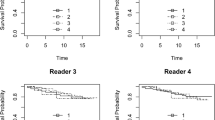Abstract
Objective
To evaluate the effect of menopausal status on the background parenchymal enhancement (BPE) and amount of fibroglandular tissue (FGT) on breast MRI.
Methods
Retrospective review identified 1,130 women who underwent screening breast MRI between July and November 2010. In 28 of these women, breast MRI was performed both at one time point while pre- and one time point while post-menopausal (median interval 49 months). Two independent readers blinded to menopausal status used categorical scales to rate BPE (minimal/mild/moderate/marked) and FGT (fatty/scattered/heterogeneously dense/dense). Consensus was reached when there was disagreement. The sign test was used to assess changes in rating categories, and the Spearman rank and Fisher’s exact tests were used to measure correlations and associations between variables.
Results
Significant proportions of women demonstrated decreases in BPE and FGT on post-menopausal breast MRI (P = 0.0001 and P = 0.0009). BPE category was unchanged in 39 % (11/28) and decreased in 61 % (17/28) of women. FGT category was unchanged in 61 % (17/28) and decreased in 39 % (11/28) of women. Age, reason for menopause, or interval between MRIs had no significant impact on changes in BPE and FGT.
Conclusion
On MRI, BPE, and FGT decrease after menopause in significant proportions of women; BPE decreases more than FGT.
Key Points
• On MRI, background parenchymal enhancement and fibroglandular tissue both decrease after menopause.
• The reduced postmenopausal enhancement is more marked in parenchyma than fibroglandular tissue.
• Background enhancement and fibroglandular tissue seen on MRI are under hormonal influence.





Similar content being viewed by others
Abbreviations
- BPE:
-
background parenchymal enhancement
- FGT:
-
fibroglandular tissue
References
Kuhl CK, Bieling HB, Gieseke J et al (1997) Healthy premenopausal breast parenchyma in dynamic contrast-enhanced MR imaging of the breast: normal contrast medium enhancement and cyclical-phase dependency. Radiology 203:137–144
Morris EA (2007) Diagnostic breast MR imaging: current status and future directions. Radiol Clin North Am 45:863–880
Muller-Schimpfle M, Ohmenhauser K, Stoll P, Dietz K, Claussen CD (1997) Menstrual cycle and age: influence on parenchymal contrast medium enhancement in MR imaging of the breast. Radiology 203:145–149
Hambly NM, Liberman L, Dershaw DD, Brennan S, Morris EA (2011) Background parenchymal enhancement on baseline screening breast MRI: impact on biopsy rate and short-interval follow-up. AJR Am J Roentgenol 196:218–224
King V, Brooks JD, Bernstein JL, Reiner AS, Pike MC, Morris EA (2011) Background parenchymal enhancement at breast MR imaging and breast cancer risk. Radiology 260:50–60
Hattangadi J, Park C, Rembert J et al (2008) Breast stromal enhancement on MRI is associated with response to neoadjuvant chemotherapy. AJR Am J Roentgenol 190:1630–1636
Delille JP, Slanetz PJ, Yeh ED, Kopans DB, Halpern EF, Garrido L (2005) Hormone replacement therapy in postmenopausal women: breast tissue perfusion determined with MR imaging - initial observations. Radiology 235:36–41
Pfleiderer SO, Sachse S, Sauner D et al (2004) Changes in magnetic resonance mammography due to hormone replacement therapy. Breast Cancer Res 6:R232–238
Eng-Wong J, Orzano-Birgani J, Chow CK et al (2008) Effect of raloxifene on mammographic density and breast magnetic resonance imaging in premenopausal women at increased risk for breast cancer. Cancer Epidemiol Biomarkers Prev 17:1696–1701
Oksa S, Parkkola R, Luukkaala T, Maenpaa J (2009) Breast magnetic resonance imaging findings in women treated with toremifene for premenstrual mastalgia. Acta Radiol 50:984–989
Sung JS, Lee CH, Morris EA, Oeffinger KC, Dershaw DD (2011) Screening breast MR imaging in women with a history of chest irradiation. Radiology 259:65–71
American College of Radiology BI-RADS Committee (2003) Breast Imaging Reporting and Data System, 4th edn. American College of Radiology, Reston, Virginia
Landis JR, Koch GG (1977) The measurement of observer agreement for categorical data. Biometrics 33:159–174
Jansen SA, Lin VC, Giger ML, Li H, Karczmar GS, Newstead GM (2011) Normal parenchymal enhancement patterns in women undergoing MR screening of the breast. Eur Radiol 21:1374–1382
Boyd N, Martin L, Stone J, Little L, Minkin S, Yaffe M (2002) A longitudinal study of the effects of menopause on mammographic features. Cancer Epidemiol Biomarkers Prev 11:1048–1053
Author information
Authors and Affiliations
Corresponding author
Rights and permissions
About this article
Cite this article
King, V., Gu, Y., Kaplan, J.B. et al. Impact of menopausal status on background parenchymal enhancement and fibroglandular tissue on breast MRI. Eur Radiol 22, 2641–2647 (2012). https://doi.org/10.1007/s00330-012-2553-8
Received:
Revised:
Accepted:
Published:
Issue Date:
DOI: https://doi.org/10.1007/s00330-012-2553-8




